Louisiana’s history is rich with a multicultural legacy. Native Americans, European colonists, African slaves, and American settlers have all shaped it. Historic forts in Louisiana reflect its strategic importance in geopolitics, trade, and culture. These forts narrate stories of battles, negotiations, and bygone eras.
Among the historic forts in Louisiana, Fort St. Jean Baptiste, and Fort Jackson offer glimpses into the state’s colonial and Civil War periods. Each fort has its unique narrative, with walls that have seen crucial junctures in Louisiana’s history.
When visitors explore these sites, they can sense the remnants of past events and understand the state’s multifaceted heritage. Delving into these forts is like traveling through time, highlighting Louisiana’s enduring spirit and varied influences.
10 Historic Forts in Louisiana
| 1. Fort St. Jean Baptiste | 6. Fort Livingston |
| 2. Fort Jackson | 7. Fort De La Boulaye |
| 3. Fort St. Philip | 8. Fort Jesup |
| 4. Fort Pike | 9. Fort Randolph |
| 5. Fort Macomb | 10. Fort Buhlow |
1. Fort St. Jean Baptiste
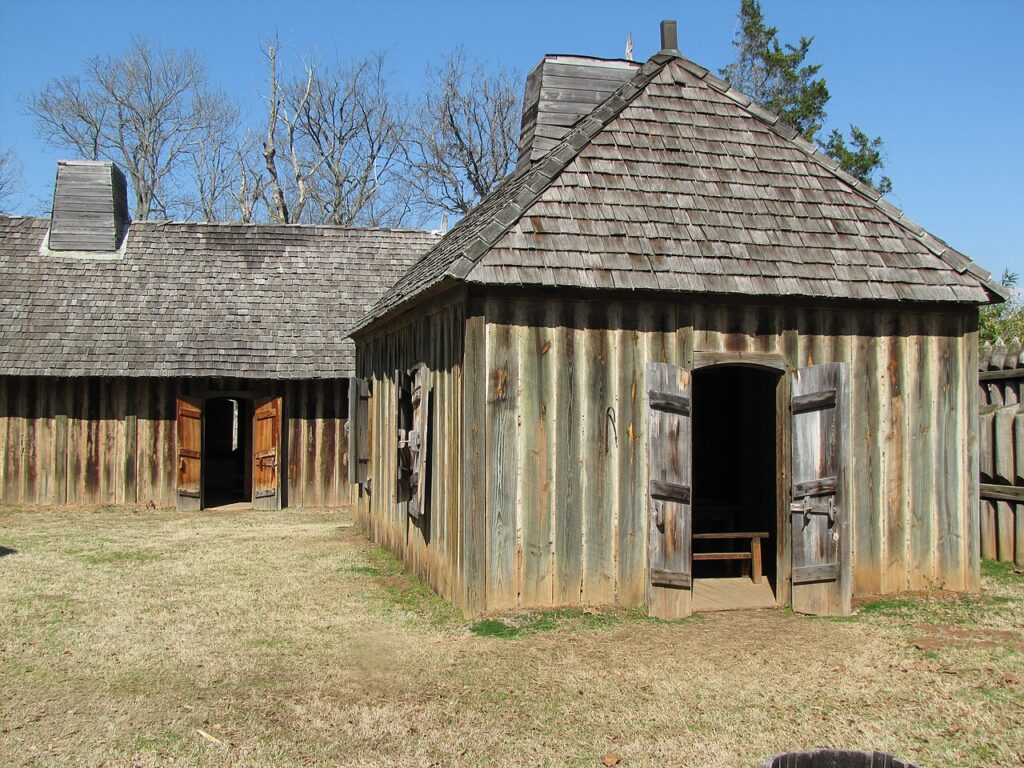
Fort St. Jean Baptiste, located in what is now the city of Natchitoches, is a testament to the early French influence and colonization in the region. Natchitoches, founded in 1714 by Louis Antoine Juchereau de St. Denis, is the oldest permanent settlement in the Louisiana Purchase territory.
Recognizing the location’s strategic importance, as it was near the Camino Real and the Red River intersection, the French decided to establish a fortification to protect their interests and trade routes.
The original fort was not the robust structure often associated with military fortifications but a hastily constructed wooden palisade. As threats from Spanish Texas and indigenous tribes grew, it was deemed necessary to bolster the fort’s defenses. Consequently, a more formidable structure was erected around 1732.
The fort included barracks, a chapel, a warehouse, and officers’ quarters, all surrounded by palisade walls. Its design was typical of French colonial forts of the period.
Strategic Importance
The fort’s presence on the Red River’s banks was crucial for the French in maintaining control over the upper Red River area. The river was a significant trade route, providing access to the continent’s interior.
The fort’s proximity to Spanish Texas made it a crucial outpost in the ongoing power struggle between European powers in the New World. Fort St. Jean Baptiste effectively deterred Spanish advances from the west and served as a bulwark against Native American tribes that other colonial powers might have influenced.
The Forts Decline and Legacy
The fort’s significance waned as time progressed and geopolitical landscapes shifted. By the late 1760s, after the French and Indian War, France ceded Louisiana to Spain, and the fort gradually lost its military importance. It was eventually abandoned, and over time, the original structures deteriorated.
Fort St. Jean Baptiste is commemorated today with a historically accurate replica near the original site. The state historic site offers visitors a chance to step back in time and experience the early days of Louisiana’s colonial history.
It features reenactments, demonstrations, and exhibits highlighting the fort’s role and the broader French influence in the region.
2. Fort Jackson
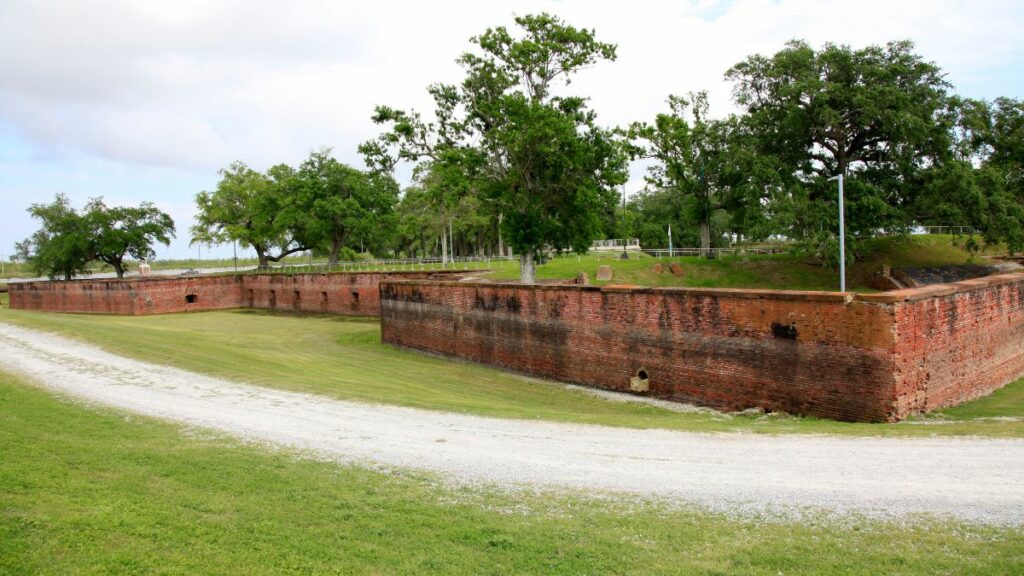
Fort Jackson, situated about 70 miles south of New Orleans in Plaquemines Parish, was a masonry fortification built as part of the U.S. government’s coastal defense strategy after the War of 1812.
Recognizing the strategic importance of the Mississippi River as both a vital commercial artery and a potential avenue of attack, the government initiated construction in the 1820s to guard the river’s mouth and protect New Orleans.
Constructed primarily using bricks, Fort Jackson featured a classic bastion design, typical of the coastal forts of its time. Its walls, several feet thick, were designed to withstand naval bombardments.
It also included a deep moat and drawbridge, providing added protection against infantry assaults. The fort was equipped with numerous artillery positions to engage enemy ships from multiple angles.
The importance of the fort became abundantly clear during the American Civil War. As a Confederate stronghold, Fort Jackson (in conjunction with its nearby sister fort, Fort St. Philip) was crucial in defending New Orleans, the largest city in the Confederacy and a key port.
The Battle of Forts Jackson and St. Philip (April 1862)
One of the most significant naval engagements of the Civil War occurred between the Confederate-held forts and a Union naval flotilla led by Flag Officer David G. Farragut. The Union aimed to bypass or capture the forts and ascend the Mississippi River to seize New Orleans.
After a fierce bombardment that lasted several days and a daring night passage by Farragut’s fleet, Fort Jackson’s defenses were heavily damaged, and the morale of its garrison was severely tested.
The successful passage of most of the Union fleet and facing inevitable capture, the fort’s Confederate garrison mutinied, leading to the fort’s eventual surrender. With Fort Jackson neutralized, New Orleans soon fell to Union forces.
Post-Civil War and Legacy
Fort Jackson served various military purposes after the Civil War, but its significance as a coastal fortification diminished with advancements in naval warfare and artillery. It was eventually decommissioned in the early 20th century.
Today, Fort Jackson is a National Historic Landmark and a public museum. Though damaged by hurricanes over the years, much of the original structure remains.
Visitors can explore the fort’s bastions, barracks, and gun emplacements, and interpretive displays provide insights into the fort’s storied past, particularly its pivotal role in the Civil War.
3. Fort St. Philip
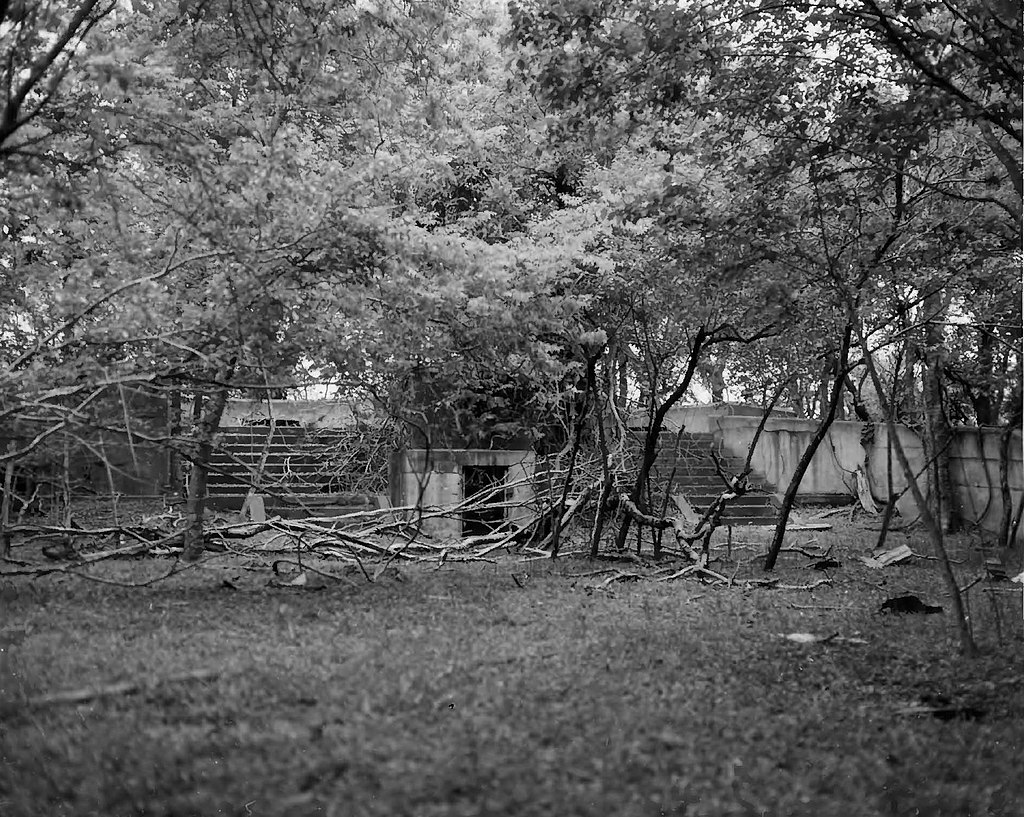
Located on the east bank of the Mississippi River, opposite Fort Jackson, Fort St. Philip has its roots in the colonial era. The location’s strategic importance, close to the mouth of the Mississippi River, was recognized as early as the 18th century.
The Spanish built a small battery on the site in the 1790s, which the French later took over, and then the United States following the Louisiana Purchase in 1803.
The fort underwent multiple renovations and expansions throughout the 19th century. By the time of the Civil War, Fort St. Philip boasted formidable masonry walls and was equipped with a range of artillery pieces.
Designed to crossfire with Fort Jackson, the two forts created a powerful defensive line against any naval force attempting to move up the Mississippi.
The location of Fort St. Philip made it a linchpin in the defense of the lower Mississippi River. Its primary purpose was to prevent enemy naval vessels from accessing the river and progressing toward New Orleans, a critical port city.
This role became even more vital during the Civil War when the control of the Mississippi became a significant objective for both the Union and the Confederacy.
The Battle of Forts Jackson and St. Philip (April 1862)
With Fort Jackson, Fort St. Philip faced a significant test during this pivotal Civil War naval engagement. The Union, under Flag Officer David G. Farragut, aimed to bypass or capture the forts to move upriver and take New Orleans. The forts endured a relentless bombardment from Union mortar boats for several days.
Although Fort St. Philip fared slightly better than Fort Jackson, the intense bombardment, combined with Farragut’s bold decision to run his fleet past the forts at night, ultimately led to a Confederate defeat. The subsequent fall of New Orleans was a significant blow to the Confederacy and marked a turning point in the war.
Post-Civil War and Legacy
Like Fort Jackson, Fort St. Philip’s importance waned after the Civil War. Though it saw some use during the Spanish-American War and was briefly occupied during World War I, advancements in military technology made its design obsolete. It gradually fell into disrepair in the 20th century.
Today, Fort St. Philip is not as accessible as Fort Jackson due to its remote location and the effects of time and nature. For those keen on history and the means to reach it, the fort offers a glimpse into a bygone era and the fierce struggles that shaped the nation.
4. Fort Pike
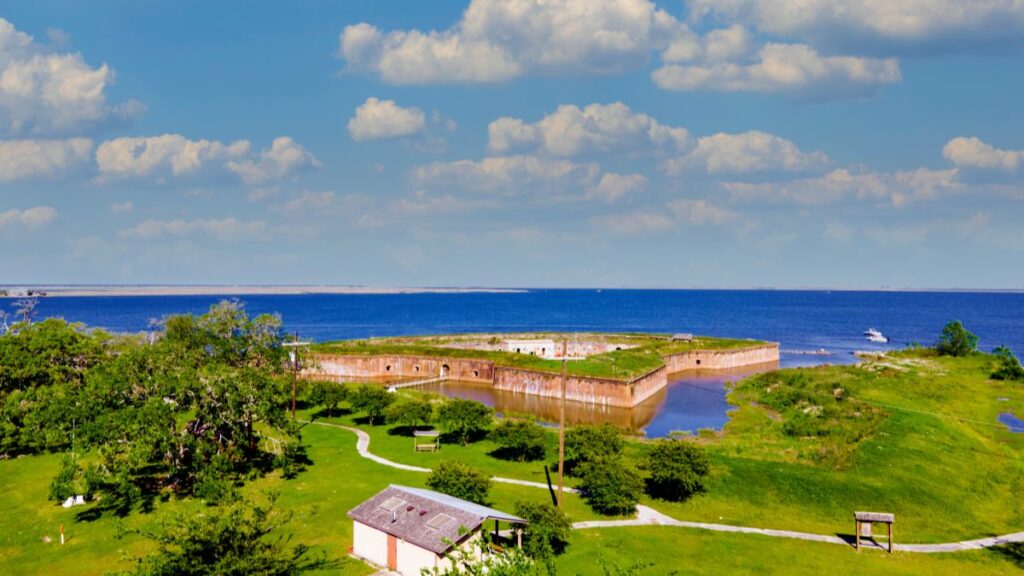
Fort Pike was named in honor of the explorer and soldier, Brigadier General Zebulon Montgomery Pike at the Rigolets Pass in New Orleans.
Its construction was initiated as a direct response to the vulnerabilities exposed during the War of 1812. The British invasion of New Orleans highlighted the need for coastal defenses, leading to the authorization of a series of fortifications.
Fort Pike was part of the “Third System” of U.S. seacoast defenses, a program initiated by Congress to create a chain of coastal fortifications along the U.S. coastline. Construction began in 1819 and was completed in the mid-1820s.
Designed with a semi-circular shape, Fort Pike was surrounded by a wide moat and featured thick masonry walls that could withstand potential bombardments. The fort had casemates to house large guns and open barbette positions on the roof. A drawbridge at the entrance and a fortified citadel within the fort protected the garrison during sieges.
Fort Pike’s primary role was to guard Lake Pontchartrain’s entrance and protect New Orleans from naval invasions via this route.
The Rigolets Pass, where the fort is located, is a crucial waterway connecting Lake Pontchartrain to the Gulf of Mexico. By controlling this passage, Fort Pike played a vital role in ensuring the safety of New Orleans and its strategic harbor.
Military Use
Throughout its active years, Fort Pike was garrisoned during several significant conflicts:
- Seminole Wars: The fort served as a staging area for troops and as a collection point for Seminole Indians being relocated westward after their removal from Florida.
- Civil War: Fort Pike was seized by Confederate forces in 1861. However, after the fall of New Orleans in 1862, it was taken over by Union forces and remained under Union control for the rest of the war.
- Spanish-American War: The fort was briefly regarrisoned, reflecting concerns about coastal invasions, though no direct combat took place there during this conflict.
Post-Military Use and Legacy
After its military usefulness diminished, Fort Pike was abandoned and eventually transferred to the State of Louisiana. Over the years, the fort suffered from time, weather, and hurricanes.
Today, Fort Pike is a State Historic Site, offering visitors a chance to explore a well-preserved example of 19th-century coastal fortification. Interpretive exhibits and periodic reenactments provide insights into the fort’s history and the soldiers’ lives there.
5. Fort Macomb
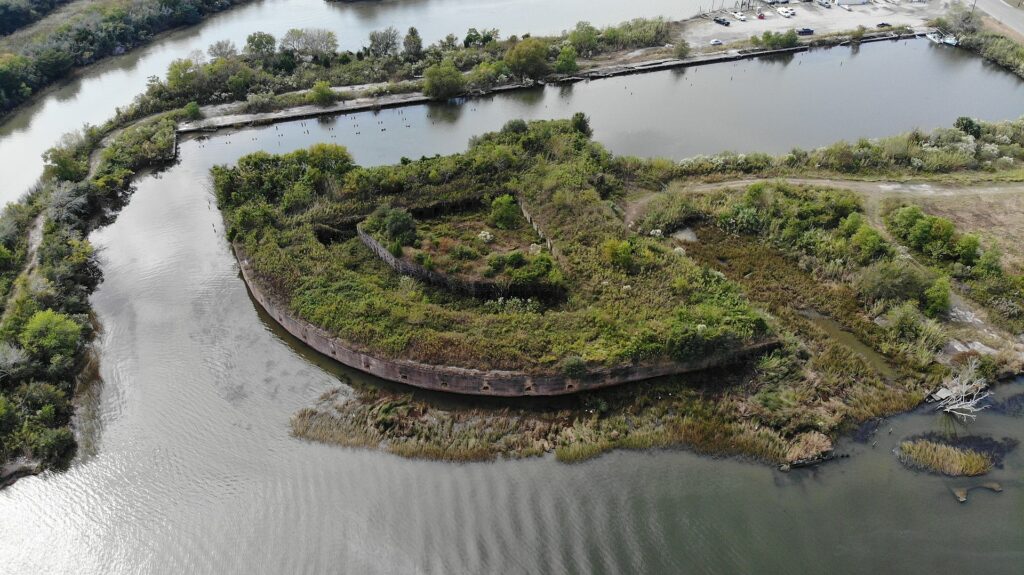
Situated near the Chef Menteur Pass in New Orleans, Fort Macomb was named in honor of Alexander Macomb, a notable general during the War of 1812.
Its inception was motivated by the same concerns that led to the construction of Fort Pike. After the War of 1812 highlighted the vulnerabilities in coastal defenses, the U.S. embarked on a nationwide fortification initiative.
Part of the “Third System” of U.S. seacoast defenses, Fort Macomb’s construction began in the 1820s. The fort’s design comprises a semi-circular brick wall augmented with a moat for additional defense.
This design was geared to repel both naval and land assaults. Within its walls, the fort featured casemates, barracks, and storage facilities, all organized to sustain the garrison in prolonged engagements.
The Chef Menteur Pass, where Fort Macomb is located, is a critical waterway, offering an alternative route to Lake Pontchartrain from the Gulf of Mexico.
The fort’s role was to guard this passage, preventing any potential naval incursions that could threaten New Orleans from the northeast, complementing Fort Pike’s defense of the Rigolets Pass.
Military Use
Fort Macomb’s active military history mirrors that of many coastal forts of its era:
- Civil War: Confederate forces occupied Fort Macomb early in the war. However, the Confederates evacuated the fort after New Orleans fell to Union forces in 1862. It subsequently came under Union control for the remainder of the war but did not see significant battle action.
- Post-Civil War Period: The fort continued to serve a military purpose for a few decades after the Civil War. However, it was deemed obsolete and decommissioned by the end of the 19th century.
Present Day and Legacy
Over the years, nature began to reclaim Fort Macomb, with vegetation growth and the impacts of weathering evident on its structures. However, the fort’s remains continue to draw interest from history enthusiasts, filmmakers, and visitors.
Fort Macomb’s architecture and location have made it an attractive site for film and television projects. While public access to the fort’s interior is restricted due to safety concerns, its exterior still evokes the era of grand coastal defenses.
6. Fort Livingston

Fort Livingston is located on Grand Terre Island, near the mouth of Barataria Pass in Louisiana. Named after Edward Livingston, a prominent jurist, statesman, and former mayor of New York City who later moved to Louisiana, the fort was conceived as a response to the vulnerabilities observed during the War of 1812.
Initiated as part of the “Third System” of U.S. seacoast defenses, construction on Fort Livingston began in the 1830s.
The fort was designed as a bastion-style fortification, employing brick and masonry to ensure durability against naval assaults. Surrounded by a moat and featuring casemated gun positions, the fort was constructed to offer maximum protection and firepower.
The location of Fort Livingston on Grand Terre Island made it a crucial defense point for New Orleans and the Louisiana coastline.
Its position at the mouth of Barataria Pass allowed it to guard one of the essential waterways that provided access to the Gulf of Mexico. By defending this pass, the fort played a role in protecting inland areas from potential naval threats.
Military Use
Fort Livingston’s operational history is marked by several key moments:
- Civil War: The fort was still under construction when the Civil War began. Despite this, Confederate forces took control of the incomplete structure in the early days of the war. It didn’t see significant combat, and after New Orleans fell to Union forces in 1862, Confederate troops evacuated the fort, leading to its occupation by Union forces.
- Post-Civil War Period: The fort’s construction was never fully completed after the war. While it was garrisoned briefly, it soon lost its military relevance as naval technology and artillery advances rendered such coastal defenses obsolete.
Fort Livingston Today
The passage of time, coupled with the effects of hurricanes and coastal erosion, has left Fort Livingston in a state of decay. Despite its dilapidated condition, the remnants of the fort serve as a reminder of the coastal defense strategies of the 19th century.
Located on an island, reaching the fort can be challenging, but those who venture to its ruins are rewarded with a unique glimpse into the past, where the walls and ramparts echo the tales of soldiers and strategies from an era gone by.
7. Fort De La Boulaye
In the early 18th century, as European powers sought to establish strongholds in the New World, the French recognized the strategic importance of the Mississippi River.
They established Fort De La Boulaye, also known as Fort Mississippi, near present-day Phoenix, Louisiana, to assert their control and dominance over this crucial waterway.
Established in 1700 under the direction of Pierre Le Moyne d’Iberville, a key figure in early French colonial efforts in Louisiana, the fort was primarily built using local timber and earth.
It was a modest structure, reflective of the early colonial fortifications of that period, designed more for function than grandeur. Its primary purpose was to deter other European powers and indigenous tribes, asserting French control over the river.
The Mississippi River was, and still is, one of the most vital waterways in North America. The French aimed to control access to the river and its surrounding territories by establishing a fort at this location.
Fort De La Boulaye’s position allowed the French to monitor and regulate traffic, ensuring their dominance in trade and diplomacy in the region.
Operational History
Despite its strategic location, Fort De La Boulaye faced numerous challenges:
- Native American Relations: The fort’s establishment was not well-received by all indigenous tribes. Some saw it as a threat to their territories and trade networks. As a result, the French at Fort De La Boulaye often had to navigate complex diplomatic relations.
- Spanish Rivalry: The Spanish, who also had interests in the region, viewed the fort as challenging their claims. This rivalry added another layer of complexity to the fort’s operations.
- Decline: Due to various factors, including flooding, indigenous resistance, and European geopolitical dynamics, the fort was abandoned by the French within a few years of its establishment.
Fort De La Boulaye Today
While Fort De La Boulaye did not endure as long as some other fortifications, its establishment marked an important chapter in the colonial history of Louisiana.
The fort’s existence underlines the lengths to which European powers went to stake their claims in the New World. Today, while physical remnants of the fort are scarce, its historical significance provides insight into the early struggles for control of the Mississippi River and the broader Gulf Coast region.
8. Fort Jesup
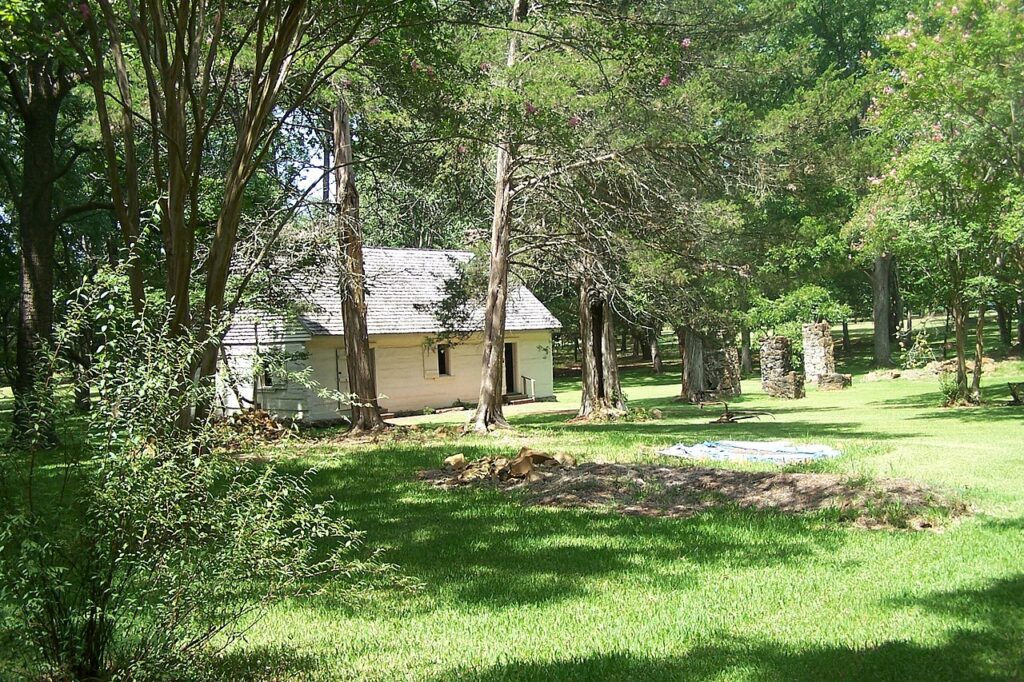
In the wake of the Louisiana Purchase in 1803, the United States found itself with vast new territories but also with ambiguously defined borders.
The western frontier with Spanish Texas was particularly contentious. To solidify its claim and ensure peace along this frontier, the U.S. Army established Fort Jesup near the town of Many, Louisiana, in the 1820s.
Commanded by General Zachary Taylor, the future U.S. president, the construction of Fort Jesup began in 1822. The fort was built using timber from the surrounding forests and was structured to house a sizable garrison.
Unlike coastal forts designed to repel naval invasions, Fort Jesup was conceived as a base of operations to project American power, ensure peace, and stabilize the frontier region.
Fort Jesup’s primary mission was to deter any encroachments from Spanish Texas and ensure the loyalty of local populations, which included a mix of American settlers, Native American tribes, and Spanish loyalists. Its presence was intended to showcase the might and resolve of the U.S. government.
Operational History
Throughout its active years, Fort Jesup played a pivotal role in various capacities:
- Border Stabilization: The fort was the primary U.S. military post along the western frontier for nearly three decades. It was crucial in maintaining peace and order in a region rife with tensions.
- Mexican-American War: The frontier dynamics changed with Texas’ transition from a Spanish territory to an independent republic and eventually a U.S. state. Fort Jesup became a key mobilization and staging point during the early stages of the Mexican-American War in the 1840s.
- Decline and Abandonment: With the U.S.-Mexican border moving further west after the war, Fort Jesup lost its strategic significance. The fort was officially abandoned by the Army in 1846.
Fort Jesup State Historic Site
Today, Fort Jesup is a State Historic Site. While many of the original buildings are no longer standing, a few have been reconstructed to offer visitors a glimpse into life on the frontier in the 19th century.
The site hosts interpretive displays, artifacts, and periodic reenactments that highlight the fort’s significance in shaping the history of Louisiana and the broader American Southwest.
The fort’s establishment and role in American expansionism underline the nation’s ambitions and challenges during its westward growth.
9. Fort Randolph
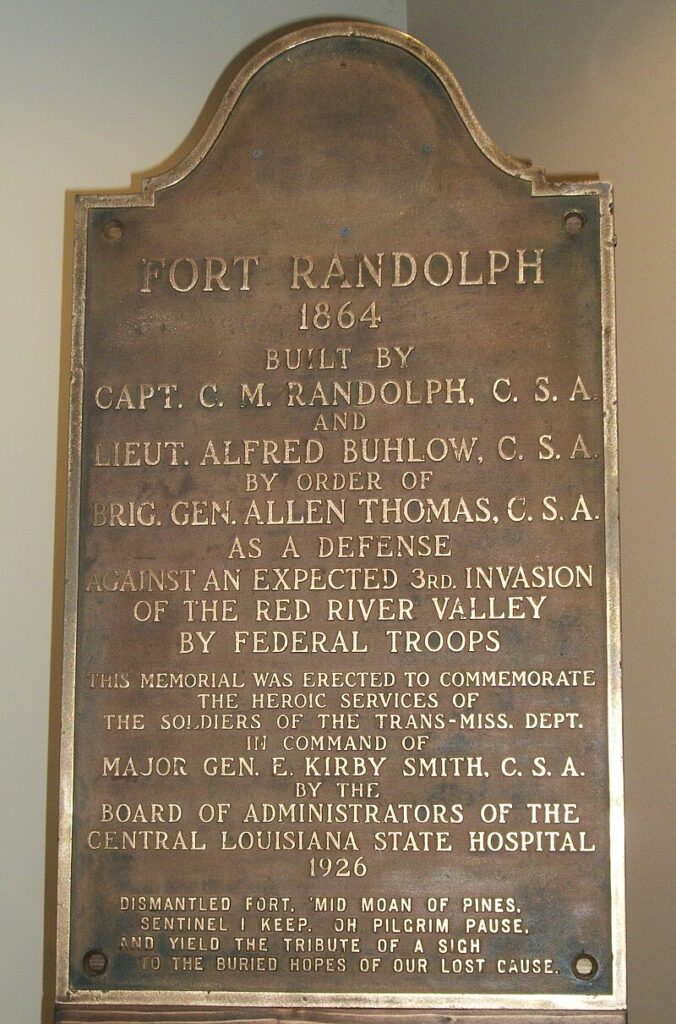
The Mississippi River became a crucial strategic point for the Union and the Confederacy as the Civil War raged. Control over the river meant dominance over supply lines, troop movements, and trade.
Baton Rouge became a focal point of military strategies as a critical location on the river. Recognizing its importance, the Confederate forces constructed Fort Randolph to defend Baton Rouge and to counter Union advances.
Constructed primarily of earthworks, Fort Randolph’s design was typical of hastily built defensive positions during the Civil War era. Earthworks provided a level of protection from enemy artillery and infantry assaults. The fort was equipped with artillery placements to counter any Union naval or ground attack.
In Baton Rouge, Fort Randolph was strategically positioned to defend a critical stretch of the Mississippi River.
Baton Rouge was not just a key port, but also a political and logistical hub. Holding the city was vital for the Confederacy for its morale and strategic position.
Operational History
- Defending Baton Rouge: Fort Randolph played a crucial role in the Confederate defense strategy for Baton Rouge. Its guns and fortifications were intended to deter or repel Union advances.
- Battle of Baton Rouge (1862): Fort Randolph became central to the city’s defenses as the Union forces targeted Baton Rouge in August 1862. While the fort played a role, the Union Army and Navy eventually pushed the Confederate forces out of Baton Rouge.
- Aftermath: After the Battle of Baton Rouge, the city remained in Union hands for the rest of the war. Fort Randolph, having served its purpose, fell into disuse.
Fort Randolph Today
Today, Fort Randolph’s remnants provide a silent testimony to the tumultuous events of the Civil War. While much of the original structure has eroded, Baton Rouge has tried to commemorate the site and its history.
The fort’s existence and its role in the war serve as a reminder of the strategic importance of Baton Rouge during one of the most challenging periods in American history.
For those interested in Civil War history, the fort’s site provides an opportunity to reflect on the events and decisions that shaped the nation’s course.
10. Fort Buhlow
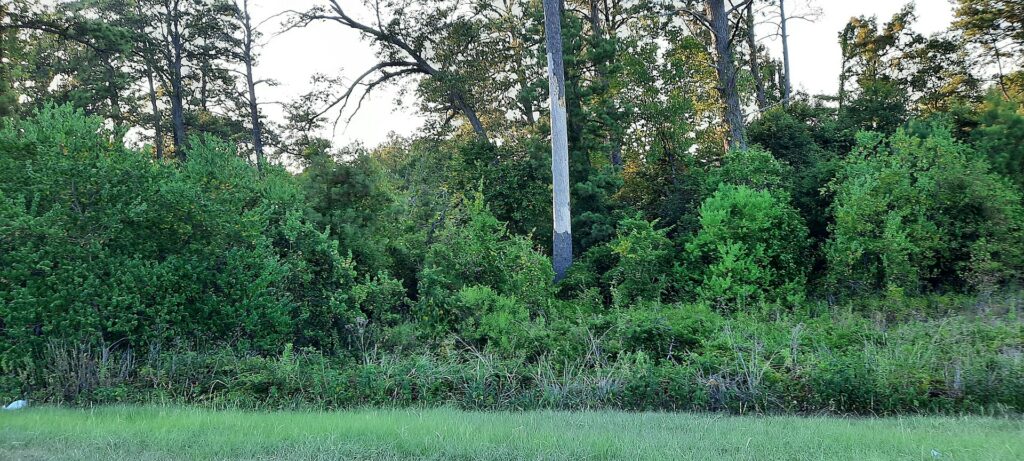
The Civil War brought heightened military activities and fortifications throughout the South, particularly in regions of strategic significance.
Central Louisiana was no exception, with its network of waterways and vital transportation routes. To bolster the defense of this critical region, Confederate forces constructed Fort Buhlow in Pineville, alongside the already-existing Fort Randolph.
Built-in the latter stages of the Civil War, Fort Buhlow was primarily an earthwork fortification. These earthworks, which consisted of mounded dirt walls, ditches, and artillery placements, were designed to offer protection from enemy fire and provide a strong defensive position against potential Union assaults.
The fort’s layout was planned to maximize its defense capabilities, incorporating trenches and other features to fend off infantry and artillery threats.
Fort Buhlow, in conjunction with Fort Randolph, formed a defensive complex to safeguard Central Louisiana. Their combined presence protected vital transportation routes, including roads and riverways, ensuring that Confederate forces could efficiently move supplies, troops, and information within the region.
Operational History
- Defensive Stance: Throughout its operational history, Fort Buhlow primarily served as a deterrent against Union advances into Central Louisiana. The fort never experienced a significant battle, but its mere existence, coupled with Fort Randolph, played a role in the region’s broader strategic landscape of the war.
- End of the War: As the Civil War drew close and the Confederacy’s position became increasingly precarious, many fortifications, including Fort Buhlow, saw diminished activity. By the end of the war, the fort had been largely abandoned.
Forts Randolph & Buhlow State Historic Site
Fort Buhlow is part of Pineville’s Forts Randolph & Buhlow State Historic Site today. The site offers visitors a chance to explore the well-preserved earthworks, view interpretive exhibits, and gain insights into the strategic importance of Central Louisiana during the Civil War.
Walking trails, interpretive signs, and periodic reenactments bring the history of the fort and its era to life, providing a tangible connection to the events and challenges of the Civil War in Louisiana.
Related: 10 Historic Forts in Massachusetts
Pre-Louisiana Purchase Forts
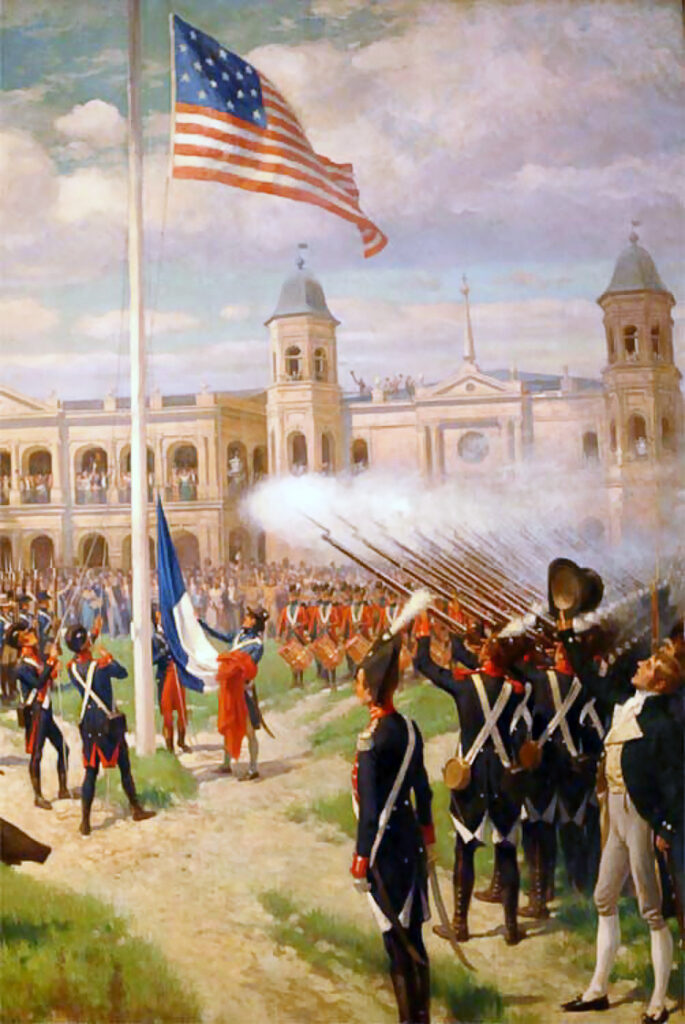
Before the United States celebrated its acquisition of the Louisiana territory, the region was a cauldron of political maneuvers, alliances, and rivalries.
Its vast expanse and strategic importance made it a prized possession for any European power that could claim it.
Spanish Dominance
Keenly aware of the region’s value, the Spanish wasted no time solidifying their presence. They constructed formidable structures to defend and mark their territories. Spanish Fort and Fort St. John were among these fortifications, which played dual roles.
Firstly, they provided military protection against hostile forces, both native and foreign. Secondly, they marked the ambiguous boundaries that separated Spanish-held territories from the neighboring French Louisiane, acting as both barriers and symbols of Spanish authority.
French Ambitions
The French were on the other side of this geopolitical tussle. Their military regiments and strategic endeavors were driven by dreams of expanding their New World empire. Fort Petite Coquilles, in particular, emerged as a significant outpost during this era.
This fortification showcased the French’s military prowess and symbolized their deep-rooted aspirations in the region. It served as a hub for French military activities, ensuring their presence was felt and their interests safeguarded.
The Balance of Power
The presence of these forts, constructed by two European superpowers, underscores the delicate balance of power in the region.
While military skirmishes and confrontations were frequent, these fortifications also played a role in diplomacy. They were constant reminders of territorial claims, serving as negotiation points when discussions between the Spanish and French took place.
Related: Army Forts in Louisiana
Key Battles & Military Campaigns in Louisiana
Louisiana’s geographical location has made it a strategic focal point in numerous military campaigns and battles. Its vast waterways and proximity to the Gulf of Mexico provided both a challenge and an advantage to military strategists over the centuries.
1. The Battle of New Orleans (1815)
- Background: As the last major battle of the War of 1812 between the United States and Britain, the Battle of New Orleans was significant for its outcome and implications.
- Details: Despite the Treaty of Ghent ending the war in late 1814, news had not reached the distant battlefronts. In January 1815, British forces aimed to capture New Orleans, hoping to control the Mississippi River. General Andrew Jackson’s diverse army, consisting of regular troops, militia, freed African Americans, pirates, and Native Americans, defended the city.
- Outcome: The American forces decisively defeated the British. This victory elevated Andrew Jackson to national prominence and symbolized American tenacity and resilience.
2. Louisiana in the Mexican War (1846-1848)
- Background: The Mexican War resulted from Texas annexation and territorial disputes between the U.S. and Mexico.
- Details: Louisiana’s militia played an essential role in this conflict. Positioned along the Gulf of Mexico, Louisiana became a critical staging ground for U.S. expeditions into Mexico.
- Outcome: The Louisiana Militia’s contributions were instrumental in achieving several key victories. The war concluded with the Treaty of Guadalupe Hidalgo, significantly expanding U.S. territories.
3. The Seminole Wars (1816-1858)
- Background: A series of conflicts between the U.S. and the Seminole tribe in Florida, the Seminole Wars highlighted the challenges and strategic importance of the Gulf Coast.
- Details: Louisiana, with its proximity to the conflict zone, became a crucial strategic point for U.S. military operations. The Gulf Coasts provided both logistical routes and defensive challenges.
- Outcome: Though the Seminoles resisted fiercely, by the end of the third Seminole War, most of the tribe had been forcibly removed to Oklahoma, marking a dark chapter in American history.
4. The Civil War’s Red River Campaign (1864)
- Background: As part of the larger Civil War, the Red River Campaign aimed to assert Union control over the Western part of Confederate territory.
- Details: The Union Army, under the leadership of Admiral David Porter and Major General Nathaniel P. Banks, aimed to seize Shreveport, Louisiana, a key Confederate stronghold. A formidable Confederate troop buildup was facing them, ready to defend their territories.
- Outcome: The campaign was marked by a series of skirmishes and battles. Though the Union Army achieved some successes, the Confederate forces managed to fend off a complete capture of the region. The campaign demonstrated the strategic importance of Louisiana and its waterways during the Civil War.
Tourist Insights for History Lovers
Many of these forts are featured on the National Register of Historic Places, underlining their national significance. Visitor centers, interpretive signage, and historic markers elevate the experience for those who visit.
The Fort Buhlow State Historic Site, overlooking the Red River, is a particular draw for enthusiasts, as is the Fort St. Jean Baptiste State Historic Site with its historic markers and ties to Proctor’s Landing.
Some forts, reflecting the changing times, have even transitioned from military strongholds to amusement parks.
Related: 10 Historic Forts in Nevada
Lesser-Known Facts and Stories
While Louisiana’s major military campaigns and forts often dominate historical narratives, the lesser-known tales scattered throughout the state provide a rich tapestry of stories, shedding light on lesser-discussed facets of its military past.
1. The Remains of Bailey and His Troops in Central Louisiana
- Background: During the colonial era, numerous skirmishes took place in the Americas as European powers vied for territorial dominance. Central Louisiana, with its dense forests and strategic location, was no exception.
- Details: Captain Bailey, a lesser-known figure, led a small band of colonial troops in one such skirmish. While the exact details of their encounter might be hazy, evidence of their endeavors can be found in Central Louisiana. These vestiges of the past serve as quiet testaments to the countless unnamed battles that shaped the continent’s history.
- Current State: Today, these remains offer visitors a chance to pay homage and explore these lesser-documented events, ensuring that the contributions of such troops aren’t forgotten.
2. Confederate Ironclad Missouri in Barataria Bay
- Background: Ironclads revolutionized naval warfare during the Civil War. With steam-powered engines and iron-plated hulls, these vessels could withstand traditional cannon fire, rendering them formidable opponents.
- Details: The Confederate Ironclad Missouri was one such ship, highlighting the technological advancements of the Confederacy and its maritime aspirations.
- Current State: Today, the remnants of Missouri provide a fascinating glimpse into the evolution of maritime warfare, showcasing the South’s determination to challenge the Union on all fronts, including the sea.
3. CSA Camp Near Brashear City
- Background: As the Civil War raged, troop movements and buildups were constant. Brashear City (now known as Morgan City) was strategically important due to its location and access to critical transportation routes.
- Details: The CSA (Confederate States of America) Camp near Brashear City symbolizes the South’s military preparations. It was a focal point for troop gatherings, strategizing, and deployments. The camp witnessed the comings and goings of Confederate soldiers, echoing their hopes, fears, and determinations.
- Current State: Modern visitors to the site can still feel the weight of history, with remnants of the camp offering a tangible connection to the past. It is a stark reminder of the Confederate troop buildup and the sheer scale of the Civil War.
Conclusion: Historic Forts in Louisiana
The forts of Louisiana are not mere relics of the past. They are living testimonials to the state’s rich history, strategic importance, and the resilience of its people.
For history lovers, visiting these sites is more than a step back in time – it’s a journey through the annals of a state that has always been at the heart of America’s story.
If you have visited any of these forts, we would love to hear about your experience in the comments section below.

Cory is a website owner and content creator who enjoys fishing, history, coin collecting, and sports, among other hobbies. He is a husband and father of four.
Romans 15:4 For whatever was written in former days was written for our instruction, that through endurance and through the encouragement of the Scriptures we might have hope.


Don’t forget Fort Baton Rouge which was a Revolutionary War Fort conquered by Bernardo Galvez.
Thanks for bringing that fort to mind. I may possibly do an article on that particular fort.